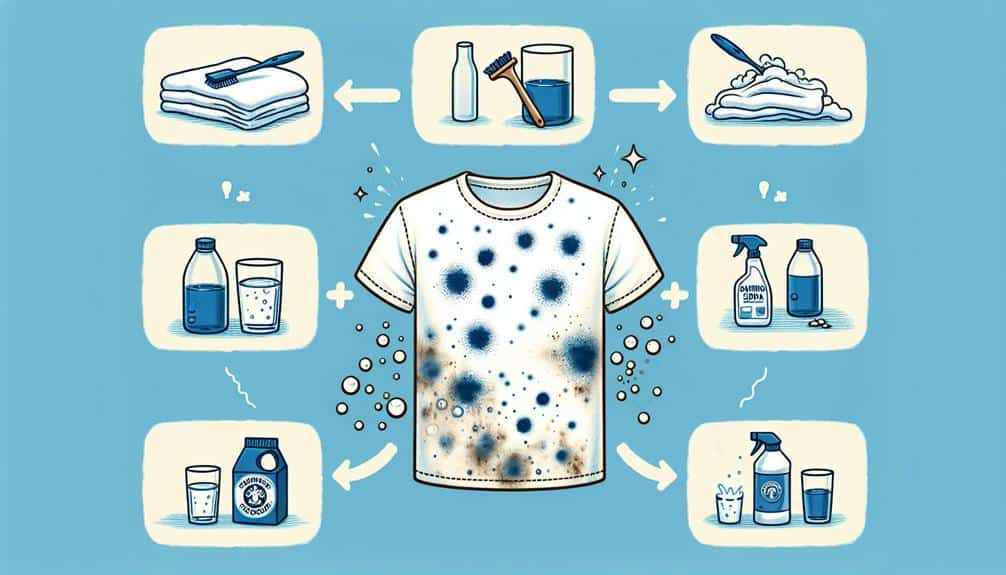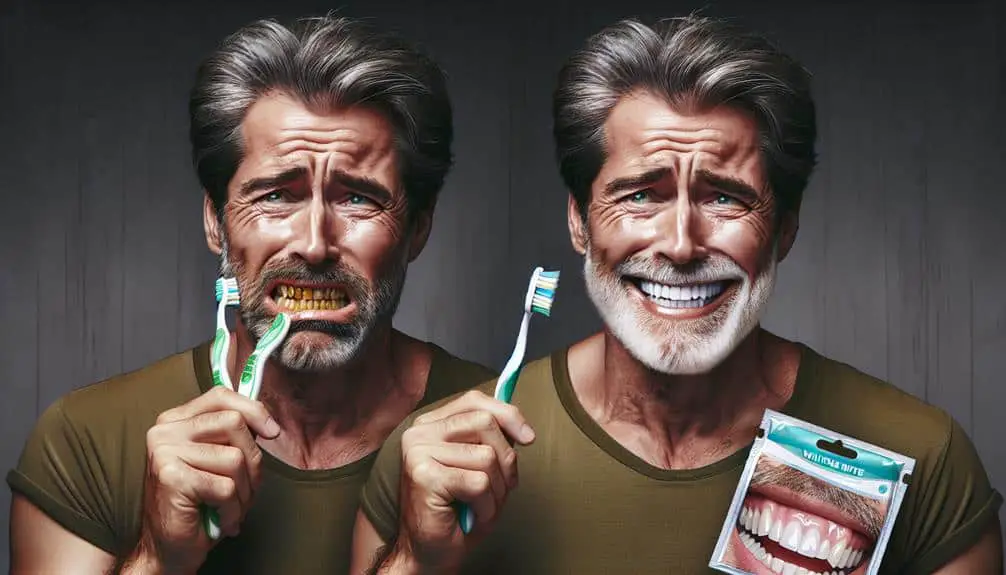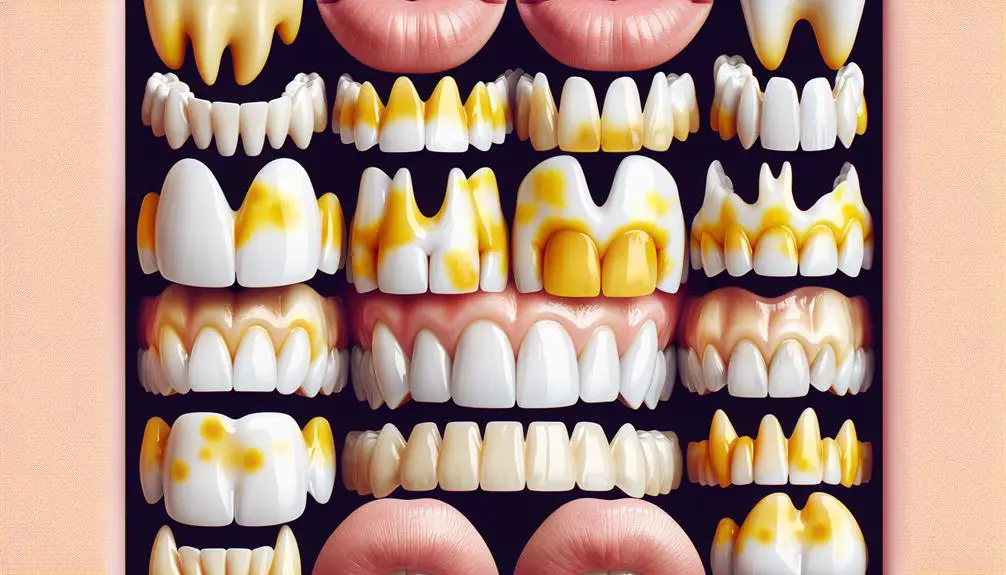When dealing with medication stains on your teeth, consider these top 10 treatments for effective removal: Professional Dental Whitening, Laser Teeth Whitening, Custom Whitening Trays, In-Office Whitening Treatments, Stain-Removing Toothpaste, Whitening Gels, Microabrasion Treatment, Dental Veneers, and Home Remedies. Each method offers distinct benefits in restoring your smile's natural brightness. By exploring these options, you can find the best solution suited to your needs and preferences, ensuring a brighter and more confident smile.
Key Points
- Professional dental whitening offers effective removal of medication stains with customized treatment options.
- In-office whitening treatments provide quick and lasting results for stubborn medication stains.
- Natural stain removal remedies like lemon juice and baking soda can help lighten medication stains.
- Cost-effective solutions, including natural bleaching agents, offer affordable options for medication stain removal.
- Precautions and testing are essential before trying any treatment for medication stain removal.
Professional Dental Whitening
If you're looking to effectively remove medication stains from your teeth, consider professional dental whitening as a reliable option. Professional dental whitening, also known as in-office teeth whitening, is a popular choice for combating tough stains caused by medications.
One significant concern that many individuals have when it comes to teeth whitening is tooth sensitivity. With professional dental whitening, your dentist can tailor the treatment to minimize sensitivity, ensuring a comfortable experience while still effectively removing medication stains.
When it comes to professional dental whitening, one of the key advantages is the long-term results it offers. Unlike over-the-counter whitening products that may provide temporary improvements, professional whitening can deliver more lasting effects. The customized approach taken during professional whitening treatments can result in a more even and natural-looking outcome that lasts longer, providing you with a brighter smile that's free from medication stains for an extended period.
Consulting with your dentist can help you determine if professional dental whitening is the right solution for your medication stain removal needs.
Laser Teeth Whitening
Considered a cutting-edge solution for achieving a brighter smile, laser teeth whitening is a highly effective method for removing tough stains caused by medications. This advanced procedure involves the use of a laser to accelerate the whitening process, providing quick and noticeable results.
- Laser Whitening Benefits
- Efficient removal of deep-seated stains.
- Reduced sensitivity compared to some traditional whitening methods.
- Quick treatment time, often completed in a single session.
- Long-lasting results when maintained properly.
When considering the costs, laser teeth whitening tends to be more expensive than professional whitening treatments. However, the benefits of faster results and potentially longer-lasting effects may outweigh the additional expense for some individuals. It's essential to consult with your dentist to discuss the best whitening option based on your specific needs and budget.
In terms of risks, laser teeth whitening may cause temporary tooth sensitivity or gum irritation, which typically subsides shortly after the procedure. Additionally, overuse of the laser treatment can lead to enamel damage, emphasizing the importance of professional guidance throughout the whitening process.
Custom Whitening Trays
Shifting from laser teeth whitening, custom whitening trays offer a personalized and convenient at-home solution for effectively removing stains caused by medications. These trays are designed to fit your teeth precisely, ensuring even application of the whitening gel for best results.
To maintain your custom whitening trays, it's essential to clean them thoroughly after each use. Rinse the trays with cool water and brush them gently with a soft-bristled toothbrush to remove any residual gel. Additionally, store the trays in their case when not in use to prevent damage or deformation.
When not using the trays, avoid exposing them to high temperatures or leaving them in direct sunlight, as this can affect their shape and fit. Tray maintenance tips also include periodically soaking them in a denture cleaning solution to disinfect and remove any stubborn stains.
Proper tray storage solutions involve keeping them away from pets or children who may accidentally damage them. By following these guidelines for tray maintenance and storage, you can prolong the life of your custom whitening trays and continue to enjoy their benefits for medication stain removal.
In-Office Whitening Treatments
When considering in-office whitening treatments, you can benefit from a chairside whitening procedure that's administered by dental professionals.
These treatments utilize professional-grade whitening agents, ensuring effective and safe results.
Additionally, with customized treatment options, you can achieve a brighter smile tailored to your specific needs and preferences.
Chairside Whitening Procedure
To achieve best results, the chairside whitening procedure involves a professional in-office treatment that effectively eliminates stains from medications.
- Immediate Results: See a significant change in the shade of your teeth after just one session.
- Tailored Treatment: Customized to your specific needs and preferences for best results.
- Professional Oversight: Guarantees the procedure is done safely and effectively by trained experts.
- Long-Lasting Effects: Enjoy a brighter smile that can last for a prolonged period with proper care.
Remember, to maintain your chairside whitening results, follow these tips:
- Practice Good Oral Hygiene: Brush and floss regularly.
- Avoid Staining Foods: Limit consumption of coffee, tea, and wine.
- Attend Regular Dental Check-Ups: Ensure your oral health is in top condition.
- Consider Touch-Up Treatments: Periodic touch-ups can help maintain your bright smile.
Professional Grade Whitening
For a more thorough and professional approach to whitening your teeth, consider opting for professional grade whitening treatments conducted in-office for best results. These treatments offer advanced techniques that aren't available in over-the-counter whitening alternatives. Professional maintenance is also easier to achieve with in-office treatments, ensuring long-lasting results.
In addition to removing medication stains, in-office whitening treatments help prevent future stains through specialized procedures. The concentration of whitening agents used in professional grade treatments is higher, leading to quicker and more effective results. If you're looking for a complete solution to medication stains and overall teeth whitening, professional grade whitening done in-office is a top choice for achieving a brighter and stain-free smile.
Customized Treatment Options
Consider exploring the tailored treatment options available through in-office whitening procedures for a personalized approach to achieving a brighter smile free from medication stains. In-office whitening treatments offer a professional solution that can be customized to suit your specific needs and preferences.
Here are some key benefits of opting for in-office whitening:
- Customized Whitening Strength: Dentists can adjust the whitening strength based on the severity of your stains.
- Faster Results: In-office treatments generally provide quicker results compared to DIY stain removal methods.
- Professional Supervision: Your treatment is overseen by dental professionals, ensuring safety and effectiveness.
- Long-Lasting Effects: In-office whitening often delivers longer-lasting results than natural remedies.
Stain-Removing Toothpaste
Achieve effective medication stain removal with the use of a specialized stain-removing toothpaste. When seeking alternatives to traditional stain removal methods, consider the benefits of toothpaste specifically formulated to combat medication stains. These toothpastes contain ingredients like baking soda, hydrogen peroxide, or silica, which work to gently polish away stains caused by medications without harming the enamel.
One advantage of stain-removing toothpaste is its convenience. Simply replace your regular toothpaste with a stain-removing one, and over time, you may notice a reduction in the discoloration caused by medications. Additionally, some individuals opt for DIY stain removal solutions, but these can be harsh on the teeth and gums if not used correctly. Stain-removing toothpaste offers a milder yet effective approach to tackling medication stains.
Remember to use the stain-removing toothpaste consistently as part of your oral care routine for best results. While it may not provide instant whitening like some treatments, over time, it can help diminish the appearance of medication stains, giving you a brighter and healthier smile.
Whitening Strips
To enhance your medication stain removal efforts, explore the benefits of incorporating whitening strips into your oral care routine. Whitening strips are a popular choice for many individuals seeking to brighten their smiles and remove stubborn stains caused by medications.
Here are some key points to ponder when using whitening strips:
- Whitening Strips Effectiveness: Whitening strips are effective at eliminating surface stains on teeth, including those caused by medications. They contain bleaching agents that help break down and lift away stains, revealing a whiter smile.
- Comparing Whitening Strip Brands: There are various whitening strip brands available on the market, each offering different strengths and formulations. It's crucial to compare brands to find one that suits your needs and preferences.
- Usage Instructions: Follow the instructions provided by the manufacturer for the best outcomes. Overusing whitening strips can lead to tooth sensitivity and gum irritation.
- Consistency is Key: For optimal outcomes, use whitening strips consistently as directed. Regular use can help maintain a brighter smile and prevent new stains from forming.
When used correctly, whitening strips can be an effective tool in combating medication stains and achieving a whiter, brighter smile.
Whitening Gels
When using whitening gels for medication stain removal, pay close attention to the gel application technique. Ensuring a uniform application across all teeth can maximize the effectiveness of the treatment.
Additionally, follow the recommended gel dwell time to achieve best results without damaging your teeth.
Gel Application Technique
Wondering how to effectively apply whitening gels for medication stain removal on your teeth? Here are some gel application tips to help you achieve the best results:
- Prepare Your Teeth: Make sure your teeth are clean and dry before applying the whitening gel.
- Use a Thin Layer: Apply a thin, even layer of whitening gel to the front surface of your teeth using a brush or applicator.
- Avoid Gums: Be cautious not to get the gel on your gums to prevent irritation.
- Follow Instructions: Always adhere to the instructions provided with the whitening gel for the recommended application technique to maximize stain removal effectiveness.
Gel Dwell Time
For best results in removing medication stains from your teeth, understanding the appropriate gel dwell time is vital for the effectiveness of whitening gels.
When using whitening gels, following gel application tips and optimizing dwell time efficiency are essential. The gel needs sufficient time to work on breaking down the stains effectively.
To guarantee maximum stain removal techniques, it's recommended to adhere to the specified dwell time as indicated on the product instructions. This practice enhances gel effectiveness and promotes better outcomes in eliminating medication stains from your teeth.
Microabrasion Treatment
To effectively address medication stains, consider utilizing the microabrasion treatment for best results. Microabrasion is a minimally invasive procedure that can help remove superficial stains from the surface of your teeth, revealing a brighter smile underneath. This technique involves using a combination of abrasive agents and mild acids to gently scrub away the stains without causing damage to the enamel.
- Effective Stain Removal: Microabrasion is highly effective in removing surface stains caused by medications, leaving your teeth looking cleaner and brighter.
- Non-Invasive Procedure: Unlike more aggressive abrasion techniques, microabrasion is a gentle and non-invasive treatment that can be suitable for many patients.
- Enamel Restoration: Microabrasion not only removes stains but can also help in restoring the enamel's natural appearance, improving the overall aesthetics of your teeth.
- Affordable Option: Compared to other cosmetic dentistry treatments like dental veneers, microabrasion is a more cost-effective solution for tackling medication stains.
Consider discussing with your dentist if microabrasion is the right treatment option for you to achieve a stain-free smile.
Dental Veneers
When it comes to maintaining your dental veneers, understanding proper cleaning techniques is key to preserving their appearance.
By implementing strategies to prevent veneer discoloration, you can prolong the lifespan of your veneers.
Regular professional maintenance is essential for ensuring that your veneers stay looking their best over time.
Veneer Cleaning Techniques
Implementing proper veneer cleaning techniques is crucial in maintaining the longevity and appearance of your dental veneers. To guarantee your veneers stay in top condition, consider the following maintenance tips:
- Use a Soft-Bristled Toothbrush: Brush gently with a soft-bristled toothbrush to avoid damaging the veneers.
- Avoid Stain-Causing Foods: Limit consumption of foods and drinks known to cause stains like coffee, tea, and red wine.
- Regular Dental Check-Ups: Visit your dentist for routine check-ups and professional cleanings to keep your veneers looking their best.
- Use Non-Abrasive Toothpaste: Opt for non-abrasive toothpaste to prevent scratching the veneer surface.
Preventing Veneer Discoloration
Maintaining the color of your dental veneers is key to preserving their appearance and longevity. To guarantee discoloration prevention and secure the longevity of your veneers, prioritize daily care.
Brush your teeth at least twice a day with a non-abrasive toothpaste to avoid scratching the veneer surface. Floss regularly to remove plaque and prevent stains between teeth. Limit consumption of staining substances like coffee, tea, and red wine. Avoid smoking, as it can cause yellowing of the veneers.
Additionally, consider lifestyle habits that can impact veneer color, such as maintaining regular dental check-ups and cleanings. By incorporating these preventive measures into your daily routine, you can help keep your veneers looking bright and natural for years to come.
Professional Veneer Maintenance
For maximum maintenance of your dental veneers, expert care is essential to guarantee their longevity and appearance stays immaculate. Professional maintenance is vital to make sure your veneers remain in top condition. Here are some key aspects of professional veneer maintenance:
- Regular Check-ups: Schedule routine appointments with your dentist to monitor the condition of your veneers.
- Professional Cleaning: Professional cleaning helps remove any buildup or stains that may impact the appearance of your veneers.
- Veneer Restoration: If your veneers show signs of wear or damage, seek professional veneer restoration to maintain their functionality and aesthetics.
- Customized Care Plan: Work with your dentist to establish a personalized care plan tailored to your specific veneer needs.
Home Remedies for Stain Removal
When dealing with medication stains, consider trying out these effective home remedies for removal. For stains on fabric or upholstery, a mixture of lemon juice and baking soda can work wonders. Lemon juice acts as a natural bleaching agent while baking soda helps to lift the stain. Simply create a paste using equal parts lemon juice and baking soda, apply it to the stained area, and let it sit for about 30 minutes before rinsing it off.
For tougher stains, a solution of hydrogen peroxide and salt can be highly effective. Mix equal parts hydrogen peroxide and salt to form a paste, then apply it to the stain. Allow it to sit for a few hours, then gently scrub and rinse the area. This combination works well for breaking down stubborn medication stains on various surfaces.
These home remedies provide natural and cost-effective ways to tackle medication stains without the need for harsh chemicals. Remember to test the solutions on a small, inconspicuous area first to guarantee they don't cause any damage.
Frequently Asked Questions
Can Medication Stain Removal Treatments Cause Tooth Sensitivity?
When contemplating medication stain removal treatments, it is crucial to be mindful of potential tooth sensitivity. Sensitivity management and exploring whitening alternatives can help address this concern. Stain prevention measures and gentle home remedies are also valuable considerations.
Are There Any Risks or Side Effects Associated With Professional Dental Whitening for Medication Stains?
When considering professional dental whitening for medication stains, be aware of potential risks and side effects. While effective, these treatments may cause tooth sensitivity or gum irritation. Consult your dentist for personalized advice.
How Long Does It Typically Take to See Results From Laser Teeth Whitening for Medication Stains?
To see results from laser teeth whitening for medication stains, it typically takes one session of about 30-60 minutes. You may need multiple sessions for best results. Maintenance is key for lasting effects. Costs vary based on location and effectiveness.
Are Custom Whitening Trays More Effective Than Over-The-Counter Whitening Products for Medication Stain Removal?
For the ultimate whitening effectiveness, custom trays excel over OTC products. They may seem pricey, but the results are worth it. With longer treatment duration, they offer superior maintenance, ensuring a dazzling smile.
Can Dental Veneers Be a Long-Term Solution for Medication Stains on Teeth?
For medication stains on teeth, dental veneers can provide a long-term solution, but they may not be the only option. Consider alternative treatments for long-term effectiveness. Consult with your dentist to explore the best solution for you.



